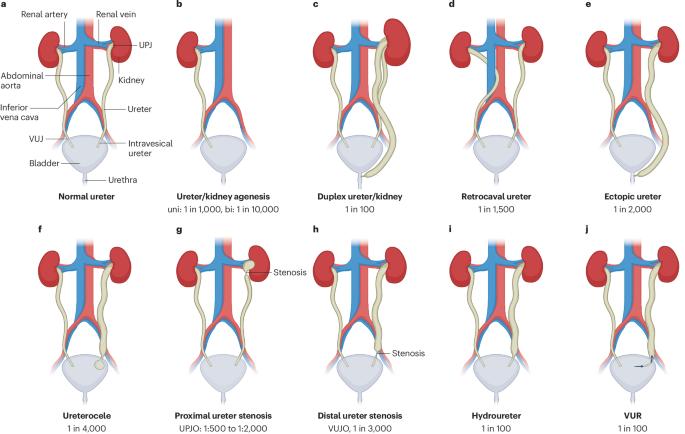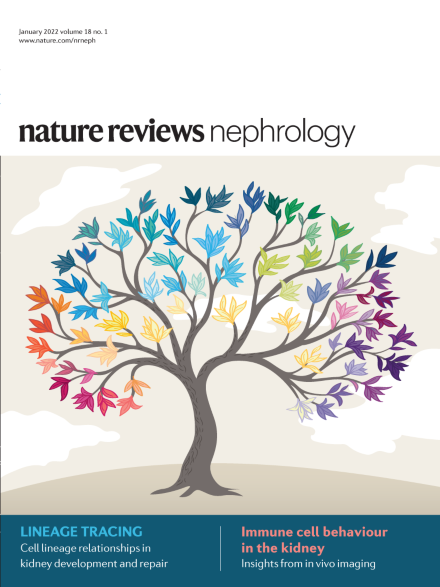输尿管发育及相关先天性异常
IF 39.8
1区 医学
Q1 UROLOGY & NEPHROLOGY
引用次数: 0
摘要
输尿管畸形是人类最常见的出生缺陷之一。虽然其中一些畸形没有症状,但另一些则与临床相关,会导致围产期死亡或在儿童期发展为肾衰竭。输尿管畸形的遗传原因和发育病因很难在人类身上进行研究;不过,通过对小鼠的胚胎学和遗传学分析,我们可以深入了解输尿管从简单组织原基形成的复杂发育程序,以及这些程序被破坏后产生的病理后果。肾管和输尿管芽形成的异常会导致输尿管(和肾脏)数量的变化,而异位输尿管芽的形成、肾管不能以泄殖腔为目标或远端输尿管不能成熟则是膀胱输尿管反流、输尿管异位、输尿管畸形和随后的输尿管积水的原因。输尿管规格、早期生长或细胞分化程序的改变现在也与各种形式的围产期输尿管积水和功能性梗阻导致的肾积水有关。对小鼠输尿管发生的细胞过程和分子驱动因素进行表征,不仅有助于了解人类输尿管异常的病因,改善预后,有利于治疗策略的开发,而且还可能证明对生成生物人工器官的努力非常重要。本文章由计算机程序翻译,如有差异,请以英文原文为准。


Ureter development and associated congenital anomalies
Malformations of the ureter are among the most common birth defects in humans. Although some of these anomalies are asymptomatic, others are clinically relevant, causing perinatal lethality or progressing to kidney failure in childhood. The genetic causes and developmental aetiology of ureteral anomalies are difficult to study in humans; however, embryological and genetic analyses in the mouse have provided insights into the complex developmental programmes that govern ureter formation from simple tissue primordia, and the pathological consequences that result from disruption of these programmes. Abnormalities in the formation of the nephric duct and ureteric bud lead to changes in the number of ureters (and kidneys), whereas the formation of ectopic ureteric buds, failure of the nephric duct to target the cloaca or failure of the distal ureter to mature underlie vesicoureteral reflux, ureter ectopia, ureterocoele and subsequent hydroureter. Alterations in ureter specification, early growth or cyto-differentiation programmes have now also been associated with various forms of perinatal hydroureter and hydronephrosis as a consequence of functional obstruction. The characterization of cellular processes and molecular drivers of ureterogenesis in the mouse may not only aid understanding of the aetiology of human ureteral anomalies, improve prognostication and benefit the development of therapeutic strategies, but may also prove important for efforts to generate a bioartificial organ. Embryological and genetic analyses in the mouse have provided insights into the complex developmental programmes that govern ureter formation and the pathological consequences that result from their disruption. This Review describes the programmes that underlie ureteral development and its associated anomalies, including the molecular control of specification, early growth and tissue differentiation.
求助全文
通过发布文献求助,成功后即可免费获取论文全文。
去求助
来源期刊

Nature Reviews Nephrology
医学-泌尿学与肾脏学
CiteScore
39.00
自引率
1.20%
发文量
127
审稿时长
6-12 weeks
期刊介绍:
Nature Reviews Nephrology aims to be the premier source of reviews and commentaries for the scientific communities it serves.
It strives to publish authoritative, accessible articles.
Articles are enhanced with clearly understandable figures, tables, and other display items.
Nature Reviews Nephrology publishes Research Highlights, News & Views, Comments, Reviews, Perspectives, and Consensus Statements.
The content is relevant to nephrologists and basic science researchers.
The broad scope of the journal ensures that the work reaches the widest possible audience.
 求助内容:
求助内容: 应助结果提醒方式:
应助结果提醒方式:


